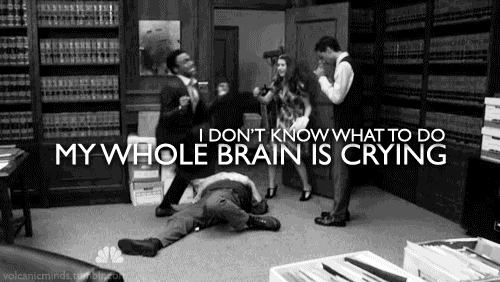Hello, everyone! 

 "Curse you" for having horrible handwriting, mysterious user who shares my username, mysteriously.
"Curse you" for having horrible handwriting, mysterious user who shares my username, mysteriously.
For example: "Aww! It's so cute" or "This is an epic piece!", or even "I love this so much!".
Just because it needs no improvements, doesn't mean you can use this bad excuse. 
Just keep on reading. 
There are still ways you can make your feedback useful, and In case you feel you have more to say, here are tips to get you started help the artist go further! Here are some:


But why not? Why are you holding back?




</div>Surprise, surprise! I'm PizzaPotatoNBacon, and I'm using this tasty article labeled as "Small Surprise #2" to cover an equally surprising topic. A topic so surprising yet so indulging, you'll have no idea why they let an insane person like me write it. Ladies and gentlemen, I introduce you to "Feedback Taboos"!
"What are these so called 'Feedback Taboos?" you are asking.
Giving Feedback on amazing artworks that don't need improvement
Giving Feedback on an art form you're not familiar with
Giving Feedback on Articles And Tutorials
Why are they considered taboos? Because they may seem 1. too hard to do, 2. too far-fetched, or 3. just outright pointless. Sure, not doing these taboos does not seem like a big deal, but it is. They are all helpful in a whole, yet rarely done, if not done at all. Feedback, as long as it's constructive and helpful, is good, regardless of the submission it was made on. 
So, as I have already mentioned, I am going to take you on a tour, show you how these "taboos" work, and help you master the art of practicing these methods, and giving more dA love. 
Let us start.
Commenting on outstanding art that don't need any improvement: How you can still help the artist

Ever see a captivating piece so amazing, you can't seem to find anything wrong with it?
What if it had amazing color harmony, great composition, awesome shading, and a lovely style, and it was pretty much perfect? Of course, we'd love to comment on it! But... we can't really see the need for improvement. Oh, how about- nah, that anatomy is correct.
Or, maybe I can say that- no, the composition is very good and needs no improvement. Oh, the colors could- eh, the color harmony is just perfect. Oh! How about adding- no... Ugh.
We can try to be helpful when we give feedback, and succeed, but there are just those masterpieces you can't seem to find a problem with. In the end, we can't seem to do anything but give in to the  and run phenomenon or using the dastardly one word/unhelpful comment excuse (and maybe
and run phenomenon or using the dastardly one word/unhelpful comment excuse (and maybe  ing afterwards).
ing afterwards). It's not so bad giving or getting short comments, as long as you can share how the piece connected with you. 
And in doing so, we have lost you to the dark side-
Okay, no, that above line is wrong. 

No. Just. NO.
- Inspire the artist.
Tell them they did a great job! Tell them that this piece is an outstanding display of their skills, and that they should keep making art! Your comment will be very helpful in giving the artist more muse to create art, maybe even inspire a little creativity within, and generally, making their day.
- Tell them to keep the work up!
Tell them what they should keep trying, why you loved the piece so much! If you have read an article on giving feedback in general, then you would know pointing out the good parts of a piece is an important part too! 
- Tell them about how it connected to you.

Does the piece relate to you in any way? If so, how? Does the message/concept affect you? How about the kind of art made, are you a fan of it? Note* What was your reaction? By letting the artist know why or how their work connected to you, the artist can determine whether or not the message/concept of their work was conveyed. How well did they convey the message/concept they wanted to send to the audience? Did they want a certain effect on the viewer? If so, were they successful with this work in getting that effect? This is the "hidden" questions of an artist (in the case they meant to have an effect and/or send a message/concept) and adding how the piece made you feel will answer most, if not all of them. It's very, very, very important for one to know such things, and by adding this, you help the artist develop their skill in audience impact or message/concept conveyance, which obviously, is one of the most important things that makes a masterpiece, a masterpiece.
Who knows? What if the artists happen to see your great feedback, and check out your page? They may return the favor by giving you great feedback! 
Commenting on an art form you're not familiar with: Overcoming one of the deepest pitfalls in giving great feedback to all
Have you ever came upon a piece asking for comments and critique, but wasn't an art form that you weren't familiar with?
Say you were an expert in Anthro art -wanting to give good feedback to others no matter what- but you stumble upon a Anime/Manga art you just feel may use some improvements. And look, the artist wants C & C on this work, really bad!
But wait! You know nothing about it, remember? You make Anthro art. You can't possibly do this. No, you just can't.

Are you afraid you'll mess up?
Are you afraid your feedback won't be useful?
Is it because you know nothing about said art form?
Is it because you don't know how everything works?
But no matter how deep it is, it is something we can escape from.
Try these, and you'll get out of it in no time!
- 1. Research the basics. - Try searching through other deviations in the same gallery and groups. What do people admire when it comes to this art form? What do they frown upon? Is the piece you're commenting on follow the rules of the art form in question? Ask yourself these questions when you see other pieces under the category. What do the experts of this art form say? What do artists strive for? And look at critiques made by others- while you shouldn't copy what they're saying, you should use their approach on the art (did they say something about the color, shading etc.). Searching is your friend.
- 2. Focus on the message or the concept. - Like I said earlier, impact/reaction is very important. It applies to every kind of art, so really, go ahead and add in your feelings towards the piece."What is the message/concept here?", "How did the art piece explain this?", "Did they convey it well enough?", "How did this make me feel?", "Is the message/concept overused?" are great questions to ask yourself. No matter the submission type, you can ask these and still get a great answer.

- 3. If you're not familiar in doing the art form, are you familiar in viewing/reading it? -
- Commenting on Photography: Do you read magazines? If so, what kind? Do you like looking at the photos? I, myself read travel magazines
 and they've helped me established what are great Urban and Rural photos, and what are not. And by that, I mean this: "What catches your eye? What keeps your eye on the piece? Why is it here again?" While not all magazines get the best photographers, all of them know what's excellent and of good quality.
and they've helped me established what are great Urban and Rural photos, and what are not. And by that, I mean this: "What catches your eye? What keeps your eye on the piece? Why is it here again?" While not all magazines get the best photographers, all of them know what's excellent and of good quality. 
But this also applies to every form of media, be it TV, Newspapers, Blogs, anywhere a great photo can pop up.
- Commenting on Literature: For all you avid novel readers out there, I'm pretty sure your input on any deviation under the fiction category would be very helpful. Why? You can tell what's a good story, with great, well-developed characters, just by reading! And you don't have to be a fellow writer to know the difference between a great writing style and a horrible one, right? You know when a writer is making the transition of events too fast, or too slow. You know when the story just dies, and you don't have to know why. You just know when and that's enough to tell the writer in order to help them improve.
How about poetry? Do you love reading it? Have you read poetry in the form this deviation was written in? How about the rhythm if it can apply? Are you familiar with how a certain form goes?
Are you a "grammar Nazi"? Nobody wants grammatical errors in their literary work! If you know correct grammar like the back of your hand, or so good that you can find a grammatical error in this article (And I've tried my best when editing this), then go ahead, make your <insert Grammar teacher/parent/general source of learning good grammar here> proud! 
- 4. Find tutorials and articles on how to critique that exact art form. - This can help a whole lot! They happen to be teach you the basics too. Not only does it teach you what's good and what's bad, it also teaches you a little bit of the art form itself. I learned quite a bit about Photography when I read a Photography Critiquing tutorial. If you don't know what they're talking about, don't fret! You can do additional searches for the terms being used (and you can use these newly learned words in your comment
 ). Kinda like studying, I admit, but it's long term and you may not have to return to the tutorial or remember the terms again as they're stuck in your head. However, they are very rare, and once you see one, click it and read it as if there's no tomorrow!
). Kinda like studying, I admit, but it's long term and you may not have to return to the tutorial or remember the terms again as they're stuck in your head. However, they are very rare, and once you see one, click it and read it as if there's no tomorrow!  This is also a reason why I highly recommend number 1.
This is also a reason why I highly recommend number 1.
Check these out to help you get started!
This is an easy to understand tutorial that ultimately covers all you need to know about critiquing photos 
This is a great tutorial if you want a really in depth lesson on critiquing photos.
A relatively simple tutorial that cover all the basics- it's really easy to understand, and it has great tips at the end. 
Never quite "understood" Poetry? Here's a very comprehensive yet easy-to-understand article you should read! And it also justifies greatly how important reaction/impact is in giving feedback. 
Giving Feedback On Tutorials And Articles
Oh, you've spotted a tutorial. It's helpful in general- but it misses some details. Oh, and there's a typo here... And a grammatical mistake here... Wait, why are you turning your face from the screen? Oh. It turns out this tutorial's color scheme is an eye sore. You read the Artist's Description, just to see if there's anything else the creator would like you to know... Oh! It says they want feedback. And look here! They want to make more tutorials in the future.
You decide to check your other tabs. And neat-o! It's an article. It's not so bad, but the grammar errors here irk you. And while it's pretty brief, somehow it looks like a wall of text, and you don't know why. You reach the end, and it has some joke about... Wow, that's offensive. Not sure the author meant it, though. Wait. It's the description. It says they want feedback on this too, since it's their first. Why do I get the feeling we've been here before?
"C & C please!", "I want feedback on this~", "This is my first tutorial, I'd like comments."
Oh, neat. They both left a Critique Box for this purpose.
...

Wait, you're not going to do anything? 
Are you saying that it's useless to give feedback on such submissions?

Every time you say, or even think that, puppies and kittens fall down, have horrible seizures, and die.
And if you don't care about or like puppies and/or kittens, then I can understand why you have no soul you find it useless.
"Why?", you ask.
Because Tutorials and articles are meant to help people, and they do. If a tutorial was inaccurate about certain settings, or maybe the creator didn't know this subject as much as you do, how would it be beneficial to those who read it? Beginners may get the wrong idea, and while there is no "correct" way of doing things, there are some things about a tutorial that can be improved. If an article was vague, and incomprehensive? That <sub></sub> code they used for every. single. text? How can it help if it's hard to understand? Is it too long? And while all articles can be helpful, their authors strive to be helpful as much as they can- so why not give them a few pointers?
"Okay, okay. So how do I critique tutorials and articles, then?"
Here are some tips to get you started!
- On Tutorials:
- If you have a tip, or a simpler way of applying that same effect (such as keyboard shortcuts or shorter ways of getting to a certain effect- like a filter or a code or whatever), put it in your comment! It can be seen by everyone, including the creator! Comment lurkers may find your tip, and they can use it. The creator of the tutorial can update it too! It's beneficial for everyone!

- Is there a more proper way of doing something in the tutorial? Does the technique defy a law or theory (such as shading and coloring)? If it does and you can see it, then add it! Is that code not working anymore? The more, the merrier.
- Talk about the actual tutorial itself. Is the text visible? Is the color scheme fine? Do they use blinding colors? Does it answer all those questions in your head? How about the layout? Were the terms understandable? Any grammatical errors or typographical errors? How comprehensive was it? Did they cover all areas? How helpful was it, overall? This is very helpful to the creator of the tutorial. It's even more appreciated if the creator is planning on making a lot of tutorials in the future.

- On Articles:
- Like I said, if you have a tip in general, or you have a certain way of doing things (which of course, is related to the article in question), it would be awesome if you throw it in that word lusting comment box! (Or critique box, if it applies)
- Is it readable? How is the formatting? A certain word used to many times? Does it look like a wall of text that ends up driving you away? Any color in here? If so, are they used well? Presentation of an article is more important than you think, so if you see an issue, don't be afraid to spout it out.
- How useful is it? Does it cover that certain topic well? Are any methods mentioned effective? Is it concise? How well does it explain, or how much of it did you understand? If the writer needs to improve on one of these areas, or if you don't understand, feel free to ask and express your opinion.
- Is it hurtful in anyway? Can it be offending to a certain group of people? Or how about how respectful the article writer was to the audience? If the article was related to behavior on the site, do you agree with the methods? Do you think there are better ways to react? If so, then you, as a person, have a right to express this. Be very respectful though, and even if the writer may have had a more disrespectful/ less helpful/ less positive way of doing things, remember, they have their own beliefs, ideals, and opinion. You can gently say they were hurtful, you can say what you think on the matter, and you can suggest a better way, but you can never force your opinion down their throat, you can never insult them, and you can never flame them. If you do so, then you're no better than they are. In fact, you're much, much worse.
What now?
Now that you know how to give good feedback on masterpieces, unfamiliar territory unfamiliar art forms, and tutorials, you're all ready to go! Now, use the knowledge you have gained in this article (assuming that you've read this all through out) and give more feedback! 
It may seem like a small thing, but remember, constructive feedback is always good. 
Oh, and a few questions, before you go:
Have you seen an amazing piece that didn't need improvement? If so, what did you do/ what do you usually do when it/when that happens?
Do you have any experiences in giving feedback on art forms you're not familiar with? How were they?
Do you give constructive feedback on tutorials and articles? Why?
And most importantly:
Do you think the GIFs used are accurate enough?
That's all I have to ask! Thanks for reading, and here, have a dancing cat and a dancing dog.


Remember, give more love, stay devious, and have a great day! 
Gifs are added for accurate visual demonstration of your facial expressions, your reactions toward the covered situations should they happen or have happened to you before, and your responses toward this article. Either that, or I may have been influenced by other articles that include the aforementioned file type. Probably the latter.





